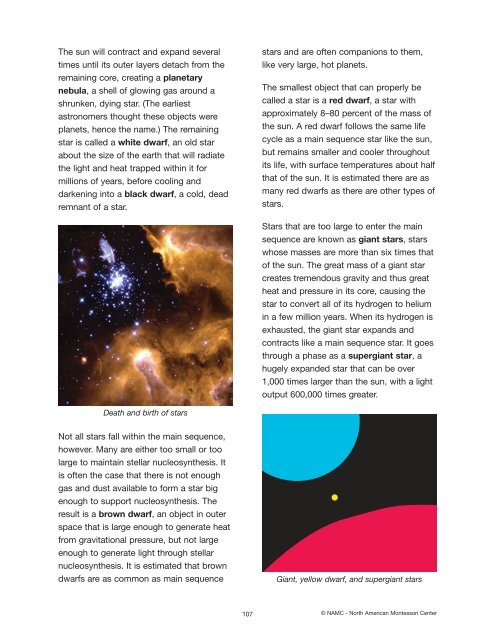THE LIFE CYCLE OF STARS - Montessori Training
THE LIFE CYCLE OF STARS - Montessori Training
THE LIFE CYCLE OF STARS - Montessori Training
Create successful ePaper yourself
Turn your PDF publications into a flip-book with our unique Google optimized e-Paper software.
The sun will contract and expand severaltimes until its outer layers detach from theremaining core, creating a planetarynebula, a shell of glowing gas around ashrunken, dying star. (The earliestastronomers thought these objects wereplanets, hence the name.) The remainingstar is called a white dwarf, an old starabout the size of the earth that will radiatethe light and heat trapped within it formillions of years, before cooling anddarkening into a black dwarf, a cold, deadremnant of a star.stars and are often companions to them,like very large, hot planets.The smallest object that can properly becalled a star is a red dwarf, a star withapproximately 8–80 percent of the mass ofthe sun. A red dwarf follows the same lifecycle as a main sequence star like the sun,but remains smaller and cooler throughoutits life, with surface temperatures about halfthat of the sun. It is estimated there are asmany red dwarfs as there are other types ofstars.Stars that are too large to enter the mainsequence are known as giant stars, starswhose masses are more than six times thatof the sun. The great mass of a giant starcreates tremendous gravity and thus greatheat and pressure in its core, causing thestar to convert all of its hydrogen to heliumin a few million years. When its hydrogen isexhausted, the giant star expands andcontracts like a main sequence star. It goesthrough a phase as a supergiant star, ahugely expanded star that can be over1,000 times larger than the sun, with a lightoutput 600,000 times greater.Death and birth of starsNot all stars fall within the main sequence,however. Many are either too small or toolarge to maintain stellar nucleosynthesis. Itis often the case that there is not enoughgas and dust available to form a star bigenough to support nucleosynthesis. Theresult is a brown dwarf, an object in outerspace that is large enough to generate heatfrom gravitational pressure, but not largeenough to generate light through stellarnucleosynthesis. It is estimated that browndwarfs are as common as main sequenceGiant, yellow dwarf, and supergiant stars107 © NAMC - North American <strong>Montessori</strong> Center



